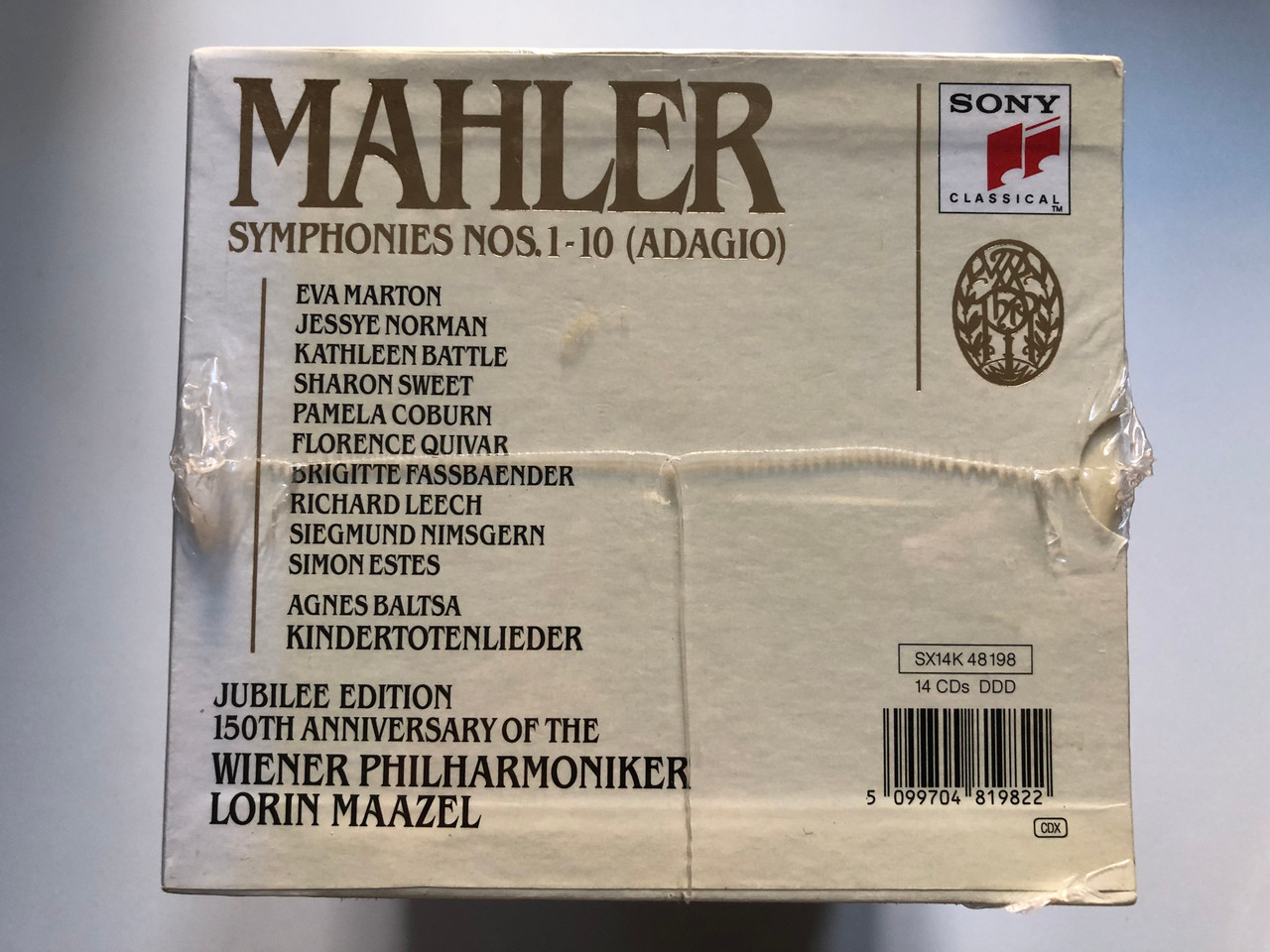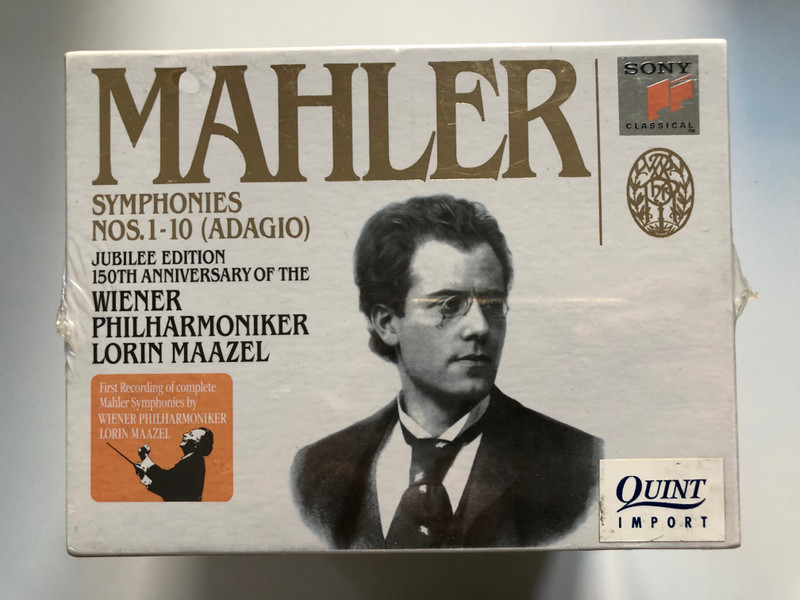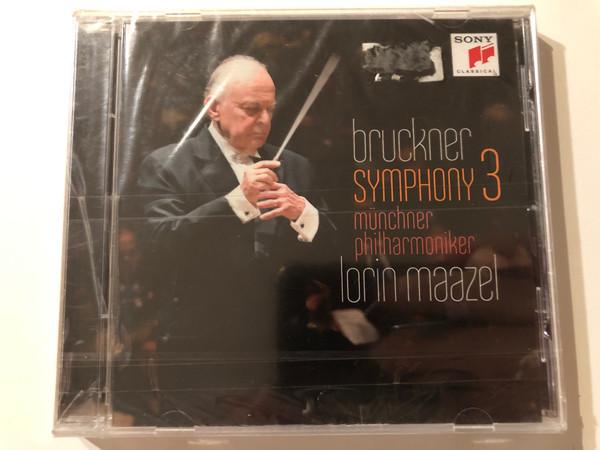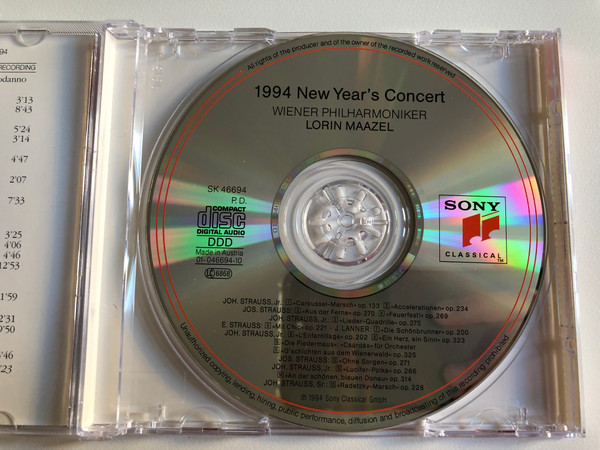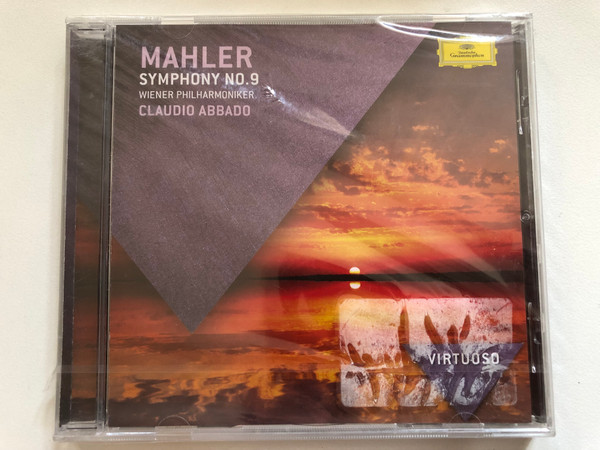Mahler - Symphonies Nos. 1-10 (Adagio) / Jubilee Edition 150th anniversary of the Wiener Philharmoniker, Lorin Maazel / Sony Classical 14x Audio CD / SX14K 48198
UPC 5099704819822
!!! Condition of CD is USED - LIKE NEW !!!
The Symphony No. 1 in D major by Gustav Mahler was mainly composed between late 1887 and March 1888, though it incorporates music Mahler had composed for previous works. It was composed while Mahler was second conductor at the Leipzig Opera, Germany. Although in his letters Mahler almost always referred to the work as a symphony, the first two performances described it as a symphonic poem and as a tone poem in symphonic form respectively. The work was premièred at the Vigadó Concert Hall, Budapest, in 1889, but was not well received. Mahler made some major revisions for the second performance, given at Hamburg in October 1893; further alterations were made in the years prior to the first publication, in late 1898. Some modern performances and recordings give the work the title Titan, despite the fact that Mahler only used this label for the second and third performances, and never after the work had reached its definitive four-movement form in 1896.
The Symphony No. 2 in C minor by Gustav Mahler, known as the Resurrection Symphony, was written between 1888 and 1894, and first performed in 1895. This symphony was one of Mahler's most popular and successful works during his lifetime. It was his first major work that established his lifelong view of the beauty of afterlife and resurrection. In this large work, the composer further developed the creativity of "sound of the distance" and creating a "world of its own", aspects already seen in his First Symphony. The work has a duration of eighty to ninety minutes and is conventionally labelled as being in the key of C minor; the New Grove Dictionary of Music and Musicians labels the work's tonality as C minor–E♭ major. It was voted the fifth-greatest symphony of all time in a survey of conductors carried out by the BBC Music Magazine.
The Symphony No. 3 in D minor by Gustav Mahler was written in 1896, or possibly only completed in that year, but composed between 1893 and 1896. It is choral, his longest piece and is the longest symphony in the standard repertoire, with a typical performance lasting around 90 to 105 minutes. It was voted one of the ten greatest symphonies of all time in a survey of conductors carried out by the BBC Music Magazine.
The Symphony No. 4 in G major by Gustav Mahler was composed from 1899 to 1900, though it incorporates a song originally written in 1892. That song, "Das himmlische Leben", presents a child's vision of heaven and is sung by a soprano in the symphony's Finale. Both smaller in orchestration and shorter in length than Mahler's earlier symphonies, the Fourth Symphony was initially planned to be in six movements, alternating between three instrumental and three vocal movements. However, the symphony's final form—begun in July 1899 at Bad Aussee and completed in August 1900 at Maiernigg—would retain only one vocal movement (the Finale) and is in four movements: Bedächtig, nicht eilen (sonata form); In gemächlicher Bewegung, ohne Hast (scherzo and trio); Ruhevoll, poco adagio (double theme and variations); and Sehr behaglich (strophic variations).
The Symphony No. 5 by Gustav Mahler was composed in 1901 and 1902, mostly during the summer months at Mahler's holiday cottage at Maiernigg. Among its most distinctive features are the trumpet solo that opens the work with a rhythmic motif similar to the opening of Ludwig van Beethoven's Symphony No. 5, the horn solos in the third movement and the frequently performed Adagietto.
The Symphony No. 6 in A minor by Gustav Mahler is a symphony in four movements, composed in 1903 and 1904, with revisions from 1906. It is sometimes nicknamed the Tragic ("Tragische"), though the origin of the name is unclear.
The Symphony No. 7 by Gustav Mahler was written in 1904–05, with repeated revisions to the scoring. It is sometimes referred to by the title Song of the Night (German: Lied der Nacht), which Mahler never knew. Although the symphony is often described as being in the key of E minor, its tonal scheme is more complicated. The symphony's first movement moves from B minor (introduction) to E minor, and the work ends with a rondo finale in C major. Thus, as Dika Newlin has pointed out, "in this symphony Mahler returns to the ideal of 'progressive tonality' which he had abandoned in the Sixth". The complexity of the work's tonal scheme was analysed in terms of "interlocking structures" by Graham George.
The Symphony No. 8 in E-flat major by Gustav Mahler is one of the largest-scale choral works in the classical concert repertoire. Because it requires huge instrumental and vocal forces it is frequently called the "Symphony of a Thousand", although the work is normally presented with far fewer than a thousand performers and the composer did not sanction that name. The work was composed in a single inspired burst at his Maiernigg villa in southern Austria in the summer of 1906. The last of Mahler's works that was premiered in his lifetime, the symphony was a critical and popular success when he conducted the Munich Philharmonic in its first performance, in Munich, on 12 September 1910.
The Symphony No. 9 by Gustav Mahler was written between 1908 and 1909, and was the last symphony that he completed. It is actually his tenth symphonic work, as Mahler gave no ordinal number to his symphonic song-cycle Das Lied von der Erde. A typical performance takes about 75 to 90 minutes. A survey of conductors voted Mahler's Symphony No. 9 the fourth greatest symphony of all time in a ballot conducted by BBC Music Magazine in 2016.
The Symphony No. 10 in F-sharp major by Gustav Mahler was written in the summer of 1910, and was his final composition. At the time of Mahler's death, the composition was substantially complete in the form of a continuous draft, but not fully elaborated or orchestrated, and thus not performable. Only the first movement is regarded as reasonably complete and performable as Mahler intended. Perhaps as a reflection of the inner turmoil he was undergoing at the time (Mahler knew he had a failing heart and his wife had been unfaithful), the 10th Symphony is arguably his most dissonant work.
| Label: |
Sony Classical – SX14K 48198 |
|---|
| Format: |
14 x CD, Compilation, Box Set
|
|---|
| Country: |
Europe |
|---|
| Released: |
|
|---|
| Genre: |
Classical |
|---|
| Style: |
|
|---|
Tracklist:
| |
|
SONY CLASSICAL SK 42141 |
|
| |
|
Symphony No. 1 |
|
| 1 |
|
Movement I: Langsam, Schlippend |
|
| 2 |
|
Movement I: Immer Sehr Gemächlich |
|
| 3 |
|
Movement II: Kräftig Bewegt, Doch Nicht Zu Schnell |
|
| 4 |
|
Movement II: Trio - Recht Gemächlich |
|
| 5 |
|
Movement II: Tempo Primo |
|
| 6 |
|
Movement III: Feierlich Und Gemessen, Ohne Zu Schleppen |
|
| 7 |
|
Movement III: Sehr Einfach Und Schlicht Wie Eine Volksweise |
|
| 8 |
|
Movement III: Wieder Etwas Bewegter, Wie Am Anfang |
|
| 9 |
|
Movement IV: Stürmisch Bewegt |
|
| |
|
SONY CLASSICAL S2K 38667
|
|
| |
|
Symphony No. 2 |
|
| 1-3 |
|
III. In Ruhig Fließender Bewegung |
|
| 2-1 |
|
IV. Urlicht - Seher Feierlich, Aber Schlicht
Soprano Vocals – Jessye Norman
|
| 2-2 |
|
V. In Tempo Des Scherzos, Wild Herausfahrend
Soprano Vocals – Éva Marton, Jessye Norman
|
| |
|
SONY CLASSICAL S2K 42403
|
|
| |
|
Symphony No. 3 |
|
| 1-1 |
|
I. Kraftig, Entscheiden |
|
| 1-5 |
|
I. Immer Dasselbe Tempo (Marsch) |
|
| 1-8 |
|
II. Tempo Di Menuetto, Sehr Mäßig |
|
| 1-10 |
|
II. Ganz Plötzlich Gemächlich, Tempo Di Menuetto |
|
| 1-11 |
|
III. Comodo, Scherzando, Ohne Hast |
|
| 1-12 |
|
III. Wieder Sehr Gemächlich, Wie Zu Anfang |
|
| 1-13 |
|
III. Sehr Gemächlich
|
| 1-15 |
|
III. Wieder Sehr Gemächlich, Beinahe Langsam |
|
| 2-1 |
|
IV. Sehr Langsam, Mistrerioso, Durchaus |
|
| 2-2 |
|
IV. Piu Mosso Subito. "Oh Mesch! Gibt Acht!" |
|
| 2-3 |
|
V. Lustig Im Tempo Und Keck Im Ausdruck. "Es Sungen Drei Engel." |
|
| 2-4 |
|
VI. Langsam, Ruhevoll, Empfunden |
|
| 2-5 |
|
VI. Nicht Mehr So Breit |
|
| 2-6 |
|
VI. Tempo I. Ruhevoll |
|
| 2-7 |
|
VI. A Tempo (Etwas Bewegter) |
|
| 2-9 |
|
VI. Langsam. Tempo I |
|
| |
|
Kindertotenleider (Song Cycle To Poems By Friedrich Rückert)
Conductor – Uwe Christian Harrer
Mezzo-soprano Vocals – Agnes Baltsa
Orchestra – Die Wiener Sängerknaben
|
| 2-10 |
|
No.1 "Nun Will Die Sonn' Hell Aufgeh'n" |
|
| 2-11 |
|
No. 2 "Nun Seh' Ich Voll, Warum So Dunkle Flammen" |
|
| 2-12 |
|
No. 3 "Wenn Dein Mütterlein" Schwer, Dumpf |
|
| 2-13 |
|
No. 4 "Oft Denk' Ich, Sie Sind Nur Ausgegangen" |
|
| 2-14 |
|
No. 5 "Im Diesen Wettr" |
|
| |
|
SONY CLASSICAL SK 39072
|
|
| |
|
Symphony No. 4 |
|
| 1 |
|
I. Bedächtig, Nicht Eilen |
|
| 2 |
|
II. Im Gemächlicher Bewegung, Ohne Hast |
|
| 4 |
|
IV. Sehr Behaglich |
|
| |
|
SONY CLASSICAL SK 42310
|
|
| |
|
Symphony No. 5 |
|
| 1 |
|
Teil 1. I. Trauermarsch, Im Gemessenem Schritt, Streng, Wie Ein Kondukt |
|
| 2 |
|
Teil 1. I. Plötzlich Schneller, Leidenschaftlich, Wild |
|
| 4 |
|
Teil 1. II. Stürmisch Bewegt, Mit Größter Vehemenz |
|
| 5 |
|
Teil 1. II. Langsam Aber Immer 2/2 |
|
| 6 |
|
Teil 1. II. Nicht Eilen |
|
| 7 |
|
Teil 2. III. Scherzo. Kraftig, Nicht Zu Schnell |
|
| 8 |
|
Teil 2. III. Etwas Ruhiger |
|
| 9 |
|
Teil 2. III. Molto Moderato |
|
| 10 |
|
Teil 2. III. A Tempo I |
|
| 11 |
|
Teil 2. III. Tempo (Subito) |
|
| 12 |
|
Teil 3. IV. Adagietto, Sehr Langsam |
|
| 13 |
|
Teil 3. V. Rondo-Finale. Allegro |
|
| 14 |
|
Teil 3. V. Nicht Eilen. A Tempo |
|
| 15 |
|
Teil 3. V. Grazioso |
|
| |
|
SONY CLASSICAL S3K 42495
|
|
| |
|
Symphony No. 6 |
|
| 1-1 |
|
I. Allegro Energico, Ma Non Troppo |
|
| 1-3 |
|
III. Andante Moderato |
|
| 2-1 |
|
IV. Finale. Allegro Moderato, Allegro Energico |
|
| 2-4 |
|
I. Allegro Risoluto, Ma Non Troppo |
|
| 2-5 |
|
I. A Tempo (Sempre L'Istesso) |
|
| 2-6 |
|
I. Subito Allegro I. Ziemlich Ruhig |
|
| 2-7 |
|
I. Adagio (Tempo Der Einleitung) |
|
| 2-8 |
|
I. Maestoso, Allegro Moderato |
|
| 2-9 |
|
II. Nachtmusik, Allegro Moderato |
|
| 2-10 |
|
II. Sempre L'Istesso Tempo. Nicht Eilen, Sehr Gemächlich |
|
| 3-1 |
|
III. Scherzo. Schattenhaft. Fließend, Aber Nicht Schnell; In Den Angfangstakten Noch Etwas Zögernd |
|
| 3-3 |
|
III. Wieder Wie Zu Anfang (Nicht Eileln) |
|
| 3-4 |
|
IV. Nachtmusik. Andante Amoroso |
|
| 3-5 |
|
IV. Takt / Measure / Mesure / Battuta 187 |
|
| 3-6 |
|
V. Rondo - Finale. Tempo I (Allegro Ordinario) |
|
| 3-7 |
|
V. Gemessen! Nicht Zu Schnell! Tempo II (Allegro Moderato Ma Energico) |
|
| 3-8 |
|
V. Tempo I (Halb Vie Viertel Des Tempo I) |
|
| 3-9 |
|
Sempre L'Istesst Tempo |
|
| |
|
SONY CLASSICAL S2K 45754
|
|
| |
|
Symphony No. 8 "Symphonie Der Tausend" (Teil I: Hymnus: Veni, Creator Spiritus)
Alto Vocals – Brigitte Fassbaender, Florence Quivar
Baritone Vocals – Siegmund Nimsgern
Bass Vocals – Simon Estes
Soprano Vocals – Pamela Coburn, Sharon Sweet
Tenor Vocals – Richard Leech (2)
|
| 1-1 |
|
Veni, Creator Spiritus! |
|
| 1-3 |
|
Infirma Nostri Corporis |
|
| 1-4 |
|
Tempo I (Allegro, Etwas Hastig) |
|
| 1-5 |
|
Infirma Nostri Corporis |
|
| 1-6 |
|
Accende Lumen Sensibus |
|
| 1-7 |
|
Que Paraclitus Diceris |
|
| 1-8 |
|
Gloria Patri Domino |
|
| |
|
Symphony No. 8 "Symphonie Der Tausend" (Teil II: Final Scene From Goethe's "Faust," Part II)
Alto Vocals – Brigitte Fassbaender, Florence Quivar
Baritone Vocals – Siegmund Nimsgern
Bass Vocals – Simon Estes
Soprano Vocals – Pamela Coburn, Sharon Sweet
Tenor Vocals – Richard Leech (2)
|
| 2-2 |
|
Piu Mosso (Allegro Moderato) |
|
| 2-3 |
|
"Waldung, Sie Schwankt Heran," Heilige Anachoreten |
|
| 2-4 |
|
"Ewiger Wonnebrand," Peter Ecstaticus |
|
| 2-5 |
|
"Wie Felsenabgrund Mir Zu Füßen," Pater Profundis |
|
| 2-6 |
|
"Gerettet Ist Das Edle Glied'" Chor Der Engel Und Chor Seliger Knaben |
|
| 2-7 |
|
"Jene Rosen, Aus Den Aänded," Chor Der Jüngeren Engel |
|
| 2-8 |
|
"Uns Bleibt Ein Erdenrest," Die Vollendeteren Engel |
|
| 2-9 |
|
"Ich Spür' Soeben," Die Jügeren Engel |
|
| 2-10 |
|
"Hier Ist Die Aussicht Frei," Doctor Matianus. "Freudig Empfangen Wir," Chor Seliger Knaben |
|
| 2-11 |
|
"Höchste Herrscherin Der Welt," Doctor Marianus |
|
| 2-12 |
|
"Jungfrau, Rein Im Schönsten Sinne," Doctor Marianus Und Chor |
|
| 2-13 |
|
Äußerst Langsam, Adagissimo |
|
| 2-14 |
|
"Die, Der Unberührbaren," Chor. "Du Schwebst Zu Höhen," Una Poenitentium Und Chor Der Büßerinnen |
|
| 2-15 |
|
"Bei Der Liebe, Die Den Füßen," Magna Peccatrix |
|
| 2-16 |
|
"Bei Dem Bronn, Zu Dem Schon Weiland," Mulier Samaritana |
|
| 2-17 |
|
"Bei Dem Hochgeweihten Orte," Maria Aegyptiaca |
|
| 2-18 |
|
"Die Du Großen Sünderinnen," Magna Peccatrix, Mulier Samaritana, Maria Aegyptiaca |
|
| 2-19 |
|
"Neige, Neige, Du Ohne Gleiche," Una Poenitentium (Gretchen) |
|
| 2-20 |
|
"Er Überwâchst Uns Schon," Selige Knaben |
|
| 2-21 |
|
"Vom Edlen Geisterchor Umgeben," Una Poenitentium (Gretchen) |
|
| 2-22 |
|
"Komm! Komm! Hebe Dich Zu Höhern Sphären," Mater Gloriosa |
|
| 2-23 |
|
"Blicket Auf," Doctor Marianus |
|
| 2-24 |
|
"Alles Vergängliche," Chous Mysticus |
|
| |
|
SONY CLASSICAL S2K 39721
|
|
| |
|
Symphony No. 9 |
|
| 1-2 |
|
II. Im Tempo Eines Gemächlichen Ländlers, Etwas Täppisch Und Sehr Derb |
|
| 1-3 |
|
III. Rondo-Burlesque, Allegro Assai, Sehr Trotzig |
|
| 2-1 |
|
IV. Adagio, Sehr Langsam Und Noch Zurückhaltend |
|
| |
|
Adagio From Symphony No. 10 (Unfinished)
|
|

